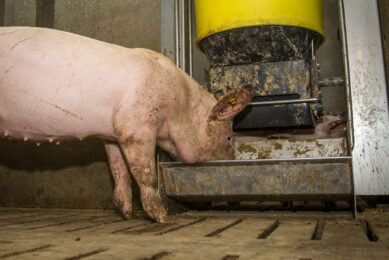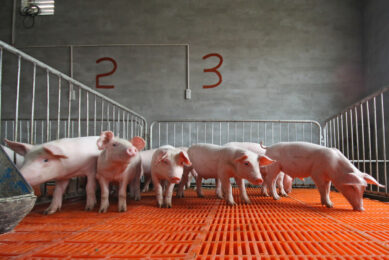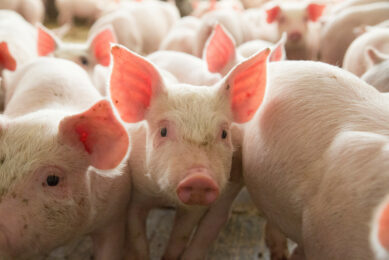Pigs can detect deficiencies in amino acids and change feed

Would pigs be able to figure out what feed to choose in case their amino acid requirements are not met? With that question, researchers at Wageningen University & Research (WUR) in the Netherlands recently set up a trial.
In itself it is no surprise that animals can be picky as to which meal to choose – that is known from various previous studies, wrote the team in a recent publication in the peer-reviewed publication called The Journal of Nutrition in December 2024. Pigs are one of those species. They wrote: “Pigs are known to show specific appetite for protein and amino acids, and optimise the ratio of protein to energy intake when given the choice between 2 diets.”
Compensating a diet deficient in amino acids
The team therefore investigated whether pigs can compensate a diet deficient in 3 amino acids by ingesting multiple diets with higher concentrations of these amino acids in a choice-feeding setting. The team chose for the amino acids threonine, tryptophan and valine, as these are indispensable for pigs. They studied the effects of the diets over a period of 4 weeks.
Setup of the pig feeding trial
In total, 96 pair-housed pigs of 5 weeks old, at an average of 7.47 kg, were exposed to 1 of 4 treatments:
- Adequate in amino acids: a low-protein diet adequate in amino acids for growth.
- Amino-acid deficient: a low-protein diet that was deficient in threonine, tryptophan and valine by 20%.
- A double option: the pigs were offered both the diets at 1 and 2.
- Four options: the low-protein diet offered at 2, plus 3 diets with each time a different amino acid (threonine, tryptophan or valine) supplemented at requirements for maximal growth, which means day 0-21 at 40%, and day 21-28 at 60%.
The team recorded both the average daily feed intake (ADFI) and average daily gain (ADG).
Pigs indeed can detect amino acid deficiencies
Having reviewed the results of the study, the researchers concluded that pigs can detect multiple amino acid deficiencies and compensate by consuming amino acid-supplemented diets.
In their conclusion, the researchers wrote: “In a 2-choice setting, pigs proportionally decreased consumption of a supplemented diet with increased dietary amino acid concentration. However, when given the choice between individual amino acid-supplemented diets, pigs proportionally decrease consumption of a highly concentrated valine diet and increase preference for a highly concentrated tryptophan diet.”
Other physiological processes than growth
Interestingly, the team added: “With higher amino acid concentrations in the supplemented diet with the combination of the 3 amino acids, piglets proportionally decrease the consumption of this supplemented diet. However, when given the choice of individually amino acid-supplemented diets, pigs proportionally decreased consumption of a diet with high valine concentration, whereas they show no aversion for a diet with high threonine concentration and a strong preference for a diet with high tryptophan concentration. The resulting amino acid intake setting differs from the intake required to attain maximal bodyweight gain, indicating that pigs might choose amino acids to prioritise other physiological processes over growth.”
The article in The Journal of Nutrition was authored by Ilaria Minussi, J. Elizabeth Bolhuis, Alfons J.M. Jansman and Walter J.J. Gerrits, all attached to Wageningen University & Research, the Netherlands.











